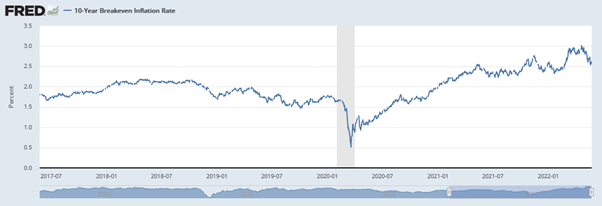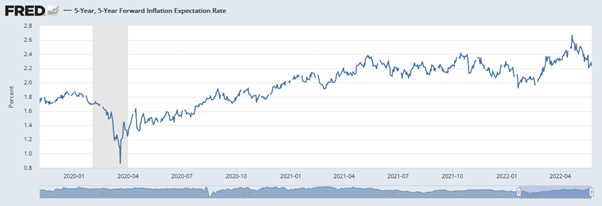Why stocks could bottom in September
This week, billionaire investor Bill Ackman sent out a tweet that got quite a lot of attention. I’m reproducing part of it here because Bill is wrong, and I want to show you why. It’s important to understand because when you see what is really happening, you’ll be in a better position to navigate this bear market.
Here’s the Tweet thread, or at least the first few parts:
"Inflation is out of control. Inflation expectations are getting out of control. Markets are imploding because investors are not confident that the Federal Reserve will stop inflation. If the Fed doesn’t do its job, the market will do the Fed’s job, and that is what is happening now.
"The only way to stop today’s raging inflation is with aggressive monetary tightening or with a collapse in the economy. With today’s unprecedented job openings, 3.6% unemployment, long-term supply/demand imbalances in energy, ag and food, housing, and labor, and with the wage-price spiral that is underway, there is no prospect for a material reduction in inflation unless the Fed aggressively raises rates, or the stock market crashes, catalyzing an economic collapse and demand destruction."
Bill isn’t wrong just because I think he is. He’s wrong because the market data says he is.
Inflation expectations are simply not getting out of control. They are actually falling. To explain, let me show you a few charts. They are really important in the inflation story, but hardly ever get mentioned in the mainstream business news.
The first is the US 10-year breakeven inflation rate (see chart below). It’s the implied average inflation rate in the US over the next 10 years. It currently sits around 2.55%. That’s still too high for the Fed’s liking. But it is down significantly from a peak of 3.02% on 21 April. So much for getting out of control.
As the Fed continues hiking in the next few months, watch for this to come down even further. In other words, long-term inflation expectations have peaked.

There’s another measure of long-term inflation expectations that has been falling even further. This next chart shows the five-year forward inflation expectation rate. In other words, it’s the market’s expectation of average inflation from 2027–32.
After peaking at 2.67% on 21 April, these longer-term inflation expectations have fallen sharply and now sit around 2.2%, where they spent most of 2021:

In fact, if you have a close look at the chart, you can see that these longer-term inflation expectations initially started falling in late 2021 and early 2022. It was only the supply shock related to the Russia/Ukraine war that saw expectations surge again in early 2022.
But the Fed is determined to crush demand to such an extent that it will bring inflation (and inflation expectations) down. Just last week, Fed Chairman Powell, at the Wall Street Journal’s Future of Everything Festival, made the following comments:
"Financial conditions overall have tightened significantly. That’s what we need to see…
"We need to see growth moving down from very high levels, and we clearly have still a job to do on cooling down demand…
"If that involves moving past broadly understood measures of neutral rates (i.e. 2.00-2.50% on Fed Funds), we won't hesitate to do that."
Ackman doesn’t think the Fed is being aggressive enough. But the above comments sound aggressive to me.
The market thinks so too. The US two-year bond yield, a good proxy for where the market thinks the Fed Funds rate is headed, peaked at 2.75% in early May. It’s now around 2.5%. That suggests another three 50 basis point hikes (in June, July, and September). But I’m not sure the Fed will even get to three.
By September, it will be clear that the US is in recession and inflation is cooling.
Also, don’t forget that quantitative tightening (QT) starts on 1 June. From this date, the Fed will shrink its balance sheet by US$47.5 billion per month for three months, and then increase that amount to $95 billion per month.
That means it ratchets up QT on 1 September.
Put simply, the stock market doesn’t like QT. It represents a loss of liquidity in that bank reserves are removed from the financial system.
The Fed last tried QT in late 2017, at just US$10 billion per month and increasing each quarter thereafter.
By the time it jumped to US$50 billion per month in October 2018, the market fell hard. The S&P 500 sank 20% in around three months. This forced the Fed to abandon its QT plans.
Bear in mind that last time around, the Fed tightened into an expanding economy. Now, it is tightening into a slowing economy with an inflation problem.
And its starting point for QT is nearly US$50 billion! Stocks aren’t going to like that.
Ackman says: "There is no prospect for a material reduction in inflation unless the Fed aggressively raises rates, or the stock market crashes, catalyzing an economic collapse and demand destruction."
The Fed is aggressively raising rates. And shrinking its balance sheet. The risk is that this will cause a stock market crash in early September as QT increases to nearly US$100 billion per month.
You’re already seeing demand destruction in the US. Companies are beginning to warn about earnings, but it's only just started. That’s why this bear market isn’t over yet.
But come September, the Fed’s tune may have changed considerably. This is why I’m looking for a bottom around that time.
The implication for investors is clear. Stay defensive and keep some cash handy for a while yet. But keep an ear out for a change of tune for the Fed. That will mark the beginning of the end of this bear market.
Aussie stocks, of course, haven’t been hit anywhere near as hard as the major US indices. That’s a good sign for our market. In fact, the Aussie bourse may be in for a prolonged period of outperformance relative to US stocks.
More on that next time…
Never miss an insight
If you're not an existing Livewire subscriber you can sign up to get free access to investment ideas and strategies from Australia's leading investors.
And you can follow my profile to stay up to date with other wires as they're published – don't forget to give them a “like”.
3 topics

